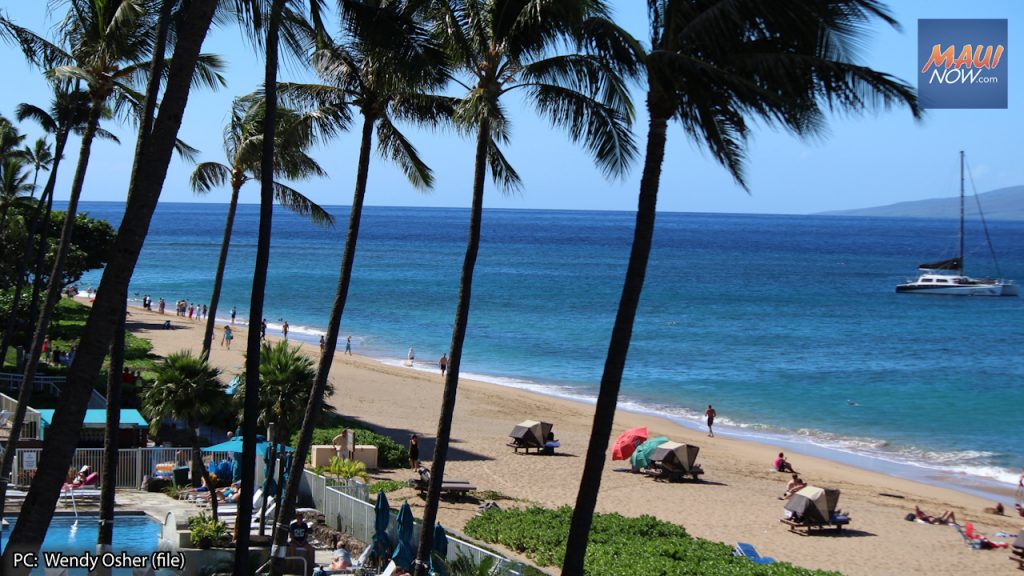Maui Tourist Arrivals Down 31% for October Versus Pre-Pandemic 2019

In October 2021, there were 189,950 visitors to Maui, a 31% decrease from pre-pandemic October 2019, and they spent 9.4% less, according to preliminary visitor statistics released by the Department of Business, Economic Development and Tourism (DBEDT).
The 48,093 fewer tourists to Maui last month (compared to two years earlier) spent $344 million, down $36 million from October 2019.
The average daily census on Maui was 52,150 visitors in October 2021 versus 59,620 visitors in October 2019.
Through the first 10 months of 2021, there were 1,861,798 visitors to Maui, down 27% from the first 10 months of 2019. This has resulted in $1.1 billion less in revenue for 2021 compared to the same time period two years ago.
For the state of Hawaiʻi, the number of tourist arrivals decreased by 31% and they spent 15% less in October 2019 than during pre-pandemic October 2019.
Last month, 550,781 visitors arrived by air service to the Hawaiian Islands, mainly from the US mainland, compared to the 796,191 visitors who arrived by air and cruise ships in October 2019.
Last month’s visitors to the islands spent $1.12 billion, about $210 million less than they did two years earlier.
The decrease in tourist arrivals coincided with Hawaiʻi Gov. David Ige’s call on Aug. 23 for Hawaiʻi residents and visitors to delay all non-essential travel until the end of October. The reason was to decrease the burden on the state’s healthcare facilities and resources due to the accelerated surge in new COVID-19 cases at the time.
The average daily census was 164,454 visitors in October 2021, compared to 39,432 in October 2020 and 215,125 in October 2019.
The majority of visitors to Hawaiʻi last month came from the US West (364,687), which was 3% more than two years earlier. They also spent $148,000 more (27.6%), stemming from a much higher average daily visitor spending ($214 per person, +21%) and a longer length of stay (8.81 days, +2.8%).
There were 157,003 visitors from the US East in October 2021, a 6% increase from October 2019. They also stayed longer and spent more compared to pre-pandemic levels.
The decrease in tourism in Hawaiʻi was due to the limited number of international travelers, especially from Japan. Visitors from that country were down 98% from two years ago, with only 2,155 in October 2021.
In October 2021, 9,657 visitors arrived from Canada, down 70% from October 2019. There were 17,279 visitors from All Other International Markets in October 2021, down 84% from two years earlier.
“The statistics we saw for October 2021 demonstrate continued strength in domestic demand for travel to the Hawaiian Islands, and we expect to see demand grow in international markets with the new streamlined federal requirements for vaccinated travelers entering the U.S., and as nations around the world begin to modify their COVID-related restrictions,” said John De Fries, President and CEO of the Hawaiʻi Tourism Authority. “The growth in demand is encouraging for our economy and a credit to the people of Hawaiʻi who have been diligent in keeping our community safe and healthy, and keeping the spirit of aloha alive.”
Last month, 4,899 trans-Pacific flights and 1,011,933 seats served the Hawaiian Islands, compared to 4,807 flights and 1,063,333 seats in October 2019.
Year-to-date 2021:
Through the first 10 months of 2021, total visitor spending was $10.16 billion, down 31% percent from the $14.63 billion spent through the first 10 months of 2019 — with tourist arrivals down 37% (5,410,436 in 2021 compared to 8,625,156 visitors in the first 10 months of 2019).
“Although we are 37% below 2019 levels, we are now on pace to end 2021 ahead of DBEDT’s third quarter economic forecast of 6.8 million visitor arrivals and $12.2 billion in visitor spending due to a strong US leisure market,” DBEDT Director Mike McCartney said. “Hawaiʻi’s visitor economy is doing better than expected and is open for business.
“We will also be starting 2022 with additional momentum with the return of international travelers and opening of the indoor Meetings, Convention and Incentive market. Hawaiʻi’s future outlook remains positive and we can expect continued economic growth and prosperity provided we remain focused on public health and safety measures to prevent and manage outbreaks of COVID-19 within our island communities.









